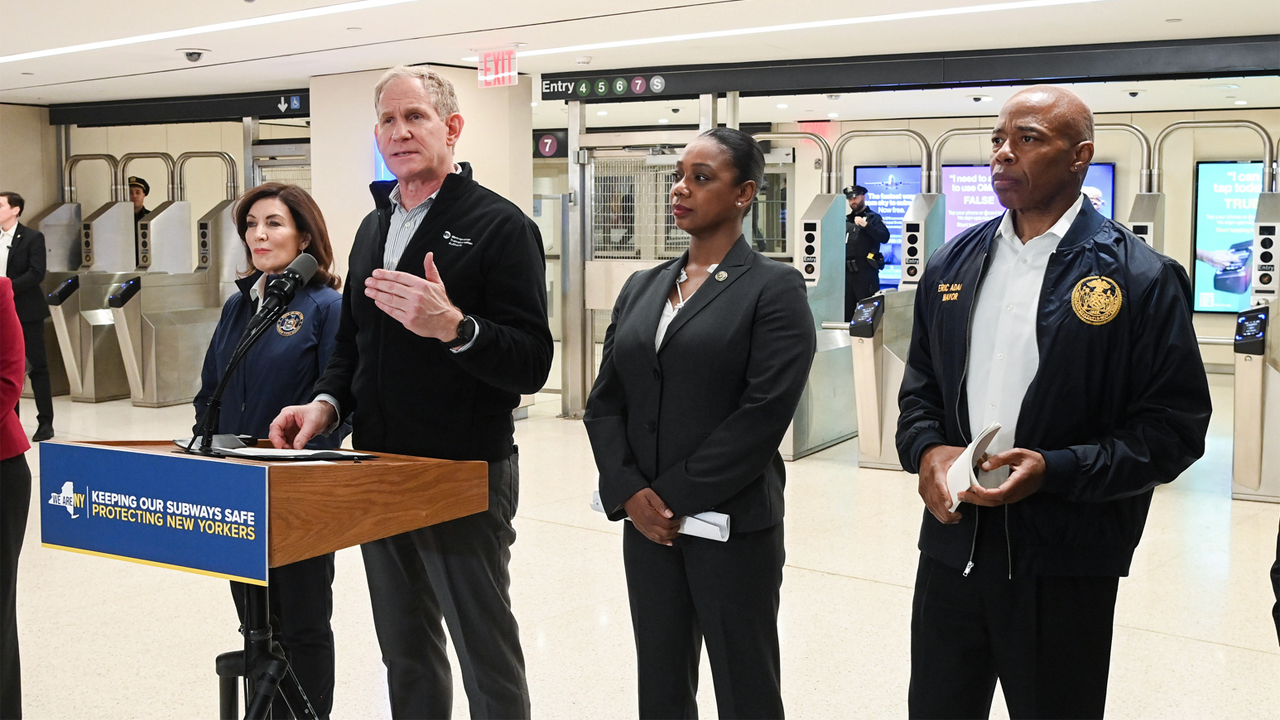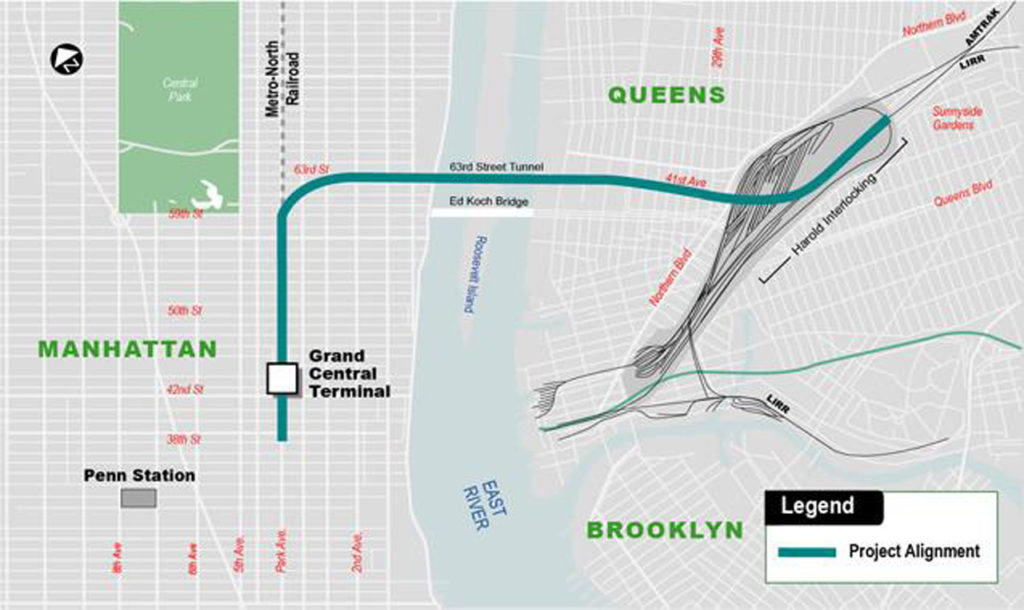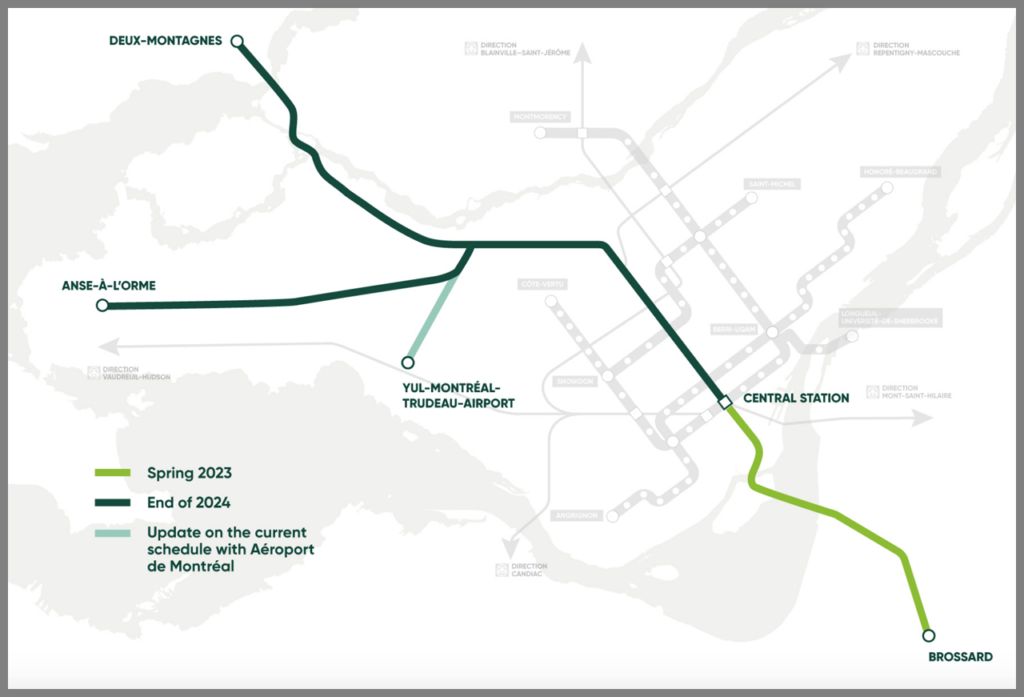
Transit Briefs: LIRR, NYCT, REM
Written by Marybeth Luczak, Executive Editor
New York Gov. Kathy Hochul (far left), New York City Mayor Eric Adams (far right), and New York City Police Commissioner Keechant Sewell joined MTA Chair and CEO Janno Lieber at Grand Central-42 Street on Oct. 22, 2022 to announce new initiatives in NYCT subway safety and security. (Marc A. Hermann / MTA)
MTA Long Island Rail Road (LIRR) crews have entered the final stages of testing ahead of Grand Central Madison’s opening. Also, new safety initiatives are under way for MTA New York City Transit subways; and CDPQ Infra reports the opening of South Shore REM (Réseau express métropolitain) stations will be delayed.
MTA LIRR on Oct. 21 reported that crews have entered the final stages of testing the escalators, elevators, HVAC systems and fire safety equipment needed to launch service to Grand Central Madison terminal, which is scheduled to start later this year, giving the commuter railroad two entry points to Manhattan’s Central Business District. See MTA’s newly released video above giving a “behind-the-scenes” look at how the terminal was built.
LIRR riders will see weekday service increase 41% system-wide when Grand Central Madison opens. The commuter railroad will add 269 trains per weekday to its current 677 for a total of 936 trains per weekday.
Construction of the East Side Access (ESA) project—originally conceived in the 1960s and developed in the 1990s—began in 2006 (see map below), and represents the largest expansion of LIRR service since the original Pennsylvania Station and its East River Tunnels opened Sept. 8, 1910. The project includes Grand Central Madison, located under Grand Central Terminal, which currently serves MTA Metro-North Railroad and MTA New York City Transit. The new connection is slated to double LIRR’s capacity into Manhattan, with up to 24 trains per hour, and cut travel time for Queens, N.Y., riders by 40 minutes per day, according to New York MTA. Other benefits of the new service: more evenly spaced trains and fewer large gaps in service; more frequent service to Queens; more frequent service on the Ronkonkoma and West Hempstead branches; a 28% increase in Brooklyn service; decreased travel times from Long Island to Manhattan; and less crowding at Penn Station.

“The new route will also enable the LIRR to accommodate all anticipated customer demand to Manhattan when Amtrak begins a project in 2024 to rebuild its East River Tunnels to Penn Station,” LIRR reported. “The project will take one of the four tunnels out of service, in sequence, over a period of three years, reducing LIRR capacity to Penn Station—capacity that the LIRR will be able to maintain to Manhattan with its new tunnels to Grand Central Madison. As ridership continues to recover following the pandemic, the new terminal allows the LIRR room for further growth in the years ahead.”
New York Gov. Kathy Hochul and New York City Mayor Eric Adams on Oct. 22 announced expanded safety initiatives for NYCT subways (watch video above). They include:
- The MTA Police Department and the New York City Police Department (NYPD) will “work together to strategically deploy more officers across the system and increase their presence on platforms and on trains, building on the progress made over the last eight months since Mayor Adams released his Subway Safety Plan,” according to MTA.
The MTA Police will take primary responsibility for policing the subway stations adjacent and linked to the four major commuter rail hubs: Penn Station, Grand Central Terminal, Atlantic Terminal, and Sutphin-Archer (Jamaica) Station. “This action will result in freeing up roughly 100 NYPD officers for deployments at other priority transit locations on trains and in stations, allowing commuters and those attempting to commit crimes to see an omnipresence of officers in the transit system,” MTA reported.
The MTA Police Department’s coverage of 60 officers per day is the equivalent of 90 additional NYPD officers given the difference in length of shifts between the departments, MTA said.
The NYPD will dramatically increase police presence in the transit system by approximately 1,200 overtime shifts every day, or approximately 10,000 overtime hours, according to MTA, which noted “New Yorkers will see officers cover platforms on extended tours in at least 300 stations during peak hours. This increase in officers will also allow dedicated Transit officers to ride hundreds of additional trains per day during peak hours. There will also be a substantial increase of officers at turnstiles that will enforce the law and deter fare evasion.”
MTA said it will also place security guards (Gate Guards) at certain subway stations “to increase security presence, to function as ‘eyes and ears’ for law enforcement, and to deter fare evasion.” - MTA will continue to install cameras in each of 6,500-plus subway cars to enhance security coverage and increase rider confidence, as well as have train conductors announce to riders when they are entering a station with police officers present. MTA said installation of cameras in subway cars will occur “at a rate of 750 cameras per month, following the completion of a procurement process, until the entire subway car fleet is camera-equipped in late 2024. Ahead of that, 100 cameras currently on hand will be installed in the coming days across subway cars.”
- To continue to address the “unhoused population” sheltering in the subway system and those who are suffering from severe mental illness, as well as build on progress of the Safe Options Support crisis intervention teams, Gov. Hochul has directed the New York State Office of Mental Health (OMH) to create two new, dedicated 25-bed units, for a total of 50 inpatient beds. OMH will also expand crisis intervention training for MTA Police, NYPD and EMS/EMT, “teaching them best practices for engaging individuals experiencing homelessness and ensuring they are fully informed of the statutory authority for the transport of individuals in need of a psychiatric evaluation,” according to MTA.
“My number one priority as Governor is keeping New Yorkers safe in the streets, in their homes, in their schools, and on the subway, and we will do whatever it takes to make our subways safer for riders,” Gov. Hochul said. “Our expanded subway safety strategy of Cops, Cameras, and Care will crack down on subway crime, help those experiencing homelessness get the support they need to get out of the system, and alleviate concerns of riders to ensure New Yorkers feel safer throughout the subway system. Building on our ongoing collaboration with the city, we will continue to work hand-in-hand with the Mayor and the NYPD to deliver the safety and security New Yorkers deserve.”
“Subway ridership has surged since Labor Day, and we remain focused on growing rider confidence through increased deployment of uniformed officers, cameras installed in every subway car, and further progress on quality-of-life issues,” MTA Chair and CEO Janno Lieber said. “The MTA is grateful to Governor Hochul and Mayor Adams for their leadership and commitment to the subways.”

CDPQ Infra, a subsidiary of Caisse de dépôt et placement du Québec, reported during an Oct. 21 news conference that the REM project’s five South Shore stations will not open before spring 2023, according to CBC News.
The 67-kilometer (41.6-mile), 26-station automated light rail network will connect downtown Montreal to the South Shore, North Shore, West Island and the airport (see map above).
The South Shore “portion of the REM was expected to be up and running last year,” according to CBC News. “The timeline has been delayed several times since then. The opening of most of the other stations on the network has been pushed back to the end of 2024.”
CDPQ Infra CEO Jean-Marc Arbaud said, “Since 2020, the pandemic and the war in Ukraine have led to a certain number of consequences difficult to predict,” according to CBC News, noting that Arbaud referred to such challenges as inflation, supply chains and the labor shortage. Crews have also dealt “with complications in the Mount Royal Tunnel, where century-old explosives were discovered [left behind from the tunnel’s original construction],” CBC News added.
“I’ve been doing projects for 40 years, including 20 years of mega projects internationally,” said Denis Rivard, the project’s vice-president, according to the CBC News report. “I’ve never seen a situation as difficult as the one we’ve experienced over the last two years.
“Personally, I am very, very proud of everything we’ve accomplished.”
CDPQ Infra officials at the news conference said “the construction of the South Shore portion of light-rail network is all but done,” according to CBC News. “Technically, Arbaud said, tests could be completed in time for the stations to be open in the a few months, but that would mean a rollout in the middle of the winter.
“CDPQ Infra describes that scenario as being ‘far from ideal.’ The group says it will spend the next few months making sure the transit system is as reliable as possible.”



